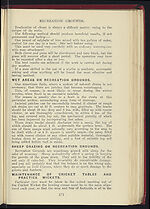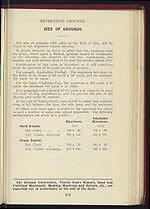1935-36
(624)
Download files
Complete book:
Individual page:
Thumbnail gallery: Grid view | List view

RECREATION GROUNDS.
one line; if this is not done, bumpy wickets must necessarily resolt.
Do not leave the preparation of match wickets until the last
moment. A first-class groundsman usually takes two or three
weeks to prepare a wicket. This is especially necessary if the
wicket is to be treated, as is very often done, with a dressing of
marl mixed with cow dung and water.
After a match, it is preferable that the repair work should be
carried out immediately. In dry weather, soak the areas to be
repaired thoroughly and patch in a careful manner, seeding those
parts where turfing is not necessary.
As the preparation of a Cricket Wicket usually entails watering
and rolling for prolonged periods with a heavy roller, those areas,
at the end of a season, are usually in a " hide-bound " condition.
Before any reinforcing with seed and dressing with marl is done,
the dead grasses should be thoroughly raked out and the ground
systematically pierced with a straight-pronged piercing fork or
graip.
All necessary weeding should be done by hand. The application
of lawn sand on Cricket Tables is not recommended; its application
needs great care and knowledge.
Complete artificial fertilisers, special grade, axe recommended as
the best and safest method of feeding.
MAINTENANCE OF CINDER RUNNING TRAGIC.
A supply of riddled ash that has been passed through a 4-in.
riddle should be kept ready for top-dressing parts of the track
that may require reinforcing.
The track should never be allowed to dry out and crumble.
It must be thoroughly saturated by means of artificial watering.
In abnormally dry weather, it may be difficult to keep a track
sufficiently moist to prevent the crumbling. A top-dressing of
calcium chloride or other suitable deliquescent will help to reduce
watering operations.
The track, after being used, should be carefully attended to.
Any depressions made by runners should be filled up by employing
a wooden squeegee and fresh material when necessary. Then it
should be brushed, watered, and rolled.
In the course of time the inside edge of the track, owing to
the extra wear and tear, will become consolidated, and naturally
sink slightly. The part affected should be pierced and the
inequalities made up with fresh topping.
After severe frost the whole surface of the track will rise, as
happens in the case of all water-bound surfaces.
Wait until the frost is out of the ground, then roll down
gradually, a light roller being used in the first instance, then roll
down with the heavy roller, squeegee, brush, and roll again to a
finished surface.
Careful maintenance attention is essential. No track will ever
be first-class if allowed to go to rack and ruin, and only worked
on just prior to a meeting being held.
572
a
t
l
i
I
one line; if this is not done, bumpy wickets must necessarily resolt.
Do not leave the preparation of match wickets until the last
moment. A first-class groundsman usually takes two or three
weeks to prepare a wicket. This is especially necessary if the
wicket is to be treated, as is very often done, with a dressing of
marl mixed with cow dung and water.
After a match, it is preferable that the repair work should be
carried out immediately. In dry weather, soak the areas to be
repaired thoroughly and patch in a careful manner, seeding those
parts where turfing is not necessary.
As the preparation of a Cricket Wicket usually entails watering
and rolling for prolonged periods with a heavy roller, those areas,
at the end of a season, are usually in a " hide-bound " condition.
Before any reinforcing with seed and dressing with marl is done,
the dead grasses should be thoroughly raked out and the ground
systematically pierced with a straight-pronged piercing fork or
graip.
All necessary weeding should be done by hand. The application
of lawn sand on Cricket Tables is not recommended; its application
needs great care and knowledge.
Complete artificial fertilisers, special grade, axe recommended as
the best and safest method of feeding.
MAINTENANCE OF CINDER RUNNING TRAGIC.
A supply of riddled ash that has been passed through a 4-in.
riddle should be kept ready for top-dressing parts of the track
that may require reinforcing.
The track should never be allowed to dry out and crumble.
It must be thoroughly saturated by means of artificial watering.
In abnormally dry weather, it may be difficult to keep a track
sufficiently moist to prevent the crumbling. A top-dressing of
calcium chloride or other suitable deliquescent will help to reduce
watering operations.
The track, after being used, should be carefully attended to.
Any depressions made by runners should be filled up by employing
a wooden squeegee and fresh material when necessary. Then it
should be brushed, watered, and rolled.
In the course of time the inside edge of the track, owing to
the extra wear and tear, will become consolidated, and naturally
sink slightly. The part affected should be pierced and the
inequalities made up with fresh topping.
After severe frost the whole surface of the track will rise, as
happens in the case of all water-bound surfaces.
Wait until the frost is out of the ground, then roll down
gradually, a light roller being used in the first instance, then roll
down with the heavy roller, squeegee, brush, and roll again to a
finished surface.
Careful maintenance attention is essential. No track will ever
be first-class if allowed to go to rack and ruin, and only worked
on just prior to a meeting being held.
572
a
t
l
i
I
Set display mode to:
![]() Universal Viewer |
Universal Viewer | ![]() Mirador |
Large image | Transcription
Mirador |
Large image | Transcription
| Games and sports in the army > 1935-36 > (624) |
|---|
| Permanent URL | https://digital.nls.uk/248716482 |
|---|
| Description | 'Games and Sports in the Army' was an annual publication produced by the British War Office between the 1930s and 1960s. This included the Second World War. It outlines the rules and regulations for games and sports played by members of the armed forces. It features names and photographs of team members, and examples of contemporary advertising. |
|---|---|
| Shelfmark | GWB.52 |

